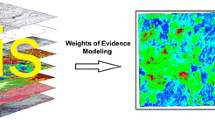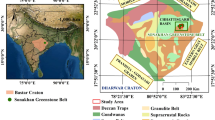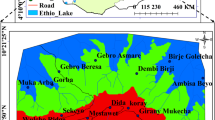Abstract
Resources potential assessment is one of the fields in geosciences, which is able to take great advantage of GIS technology as a substitution of traditional working methods. The gold resources potential in the eastern Kunlun Mountains, Qinghai Province, China was assessed by combining weights-of-evidence model with GIS spatial analysis technique. All the data sets used in this paper were derived from an established multi-source geological spatial database, which contains geological, geophysical, geochemical and remote sensing data. Three multi-class variables, i.e., structural intersection, Indosinian k-feldspar granite and regional fault, were used in proximity analysis to examine their spatial association with known gold deposits. A prospectivity map was produced by weights-of-evidence model based on seven binary evidential maps, all of which had passed a conditional independence test. The study area was divided into three target zones of high potential, moderate potential and low potential areas, among which high potential areas and moderate potential areas accounted for 20% of the total area and contained 32 of the 43 gold deposits. The results show that the gold resources potential assessment in the eastern Kunlun Mountains has a higher precision.
Similar content being viewed by others
References
Agterberg F P, Bonham-Carter G F, Cheng Q et al., 1993. Weights of evidence model and weighted logistic regression in mineral potential mapping. In: Davis J C et al. (eds.). Computers in Geology. New York: Oxford University Press, 13–32.
Agterberg F P, Bonham-Carter G F, Wright D F, 1990. Statistical pattern integration for mineral exploration. In: Gaál G et al. (eds.). Computer Applications in Resource Estimation Prediction and Assessment for Metals and Petroleum. Oxford-New York: Merriam Pergamon Press, 1–21.
Agterberg F P, Cheng Q, 2002. Conditional independence test for weights-of-evidence model. Natural Resources Research, 11(4): 249–255. DOI: 10.1023/A:1021193827501
Aspinall P J, Hill A R, 1983. Clinical inferences and decisions—I. Diagnosis and Bayes’ theorem. Ophthalmic and Physiologic Optics, 3: 295–304.
Bonham-Carter G F, 1994. Geographic Systems for Geoscientists: Modeling with GIS. Oxford: Pergamon Press.
Bonham-Carter G F, Agterberg F P, Wright D F, 1989. Weights of evidence modelling: A new approach to mapping mineral potential. In: Agterberg F P et al. (eds.). Statistical Applica tions in the Earth Sciences. Geology Survey of Canada, Paper 89-9: 171–183.
Carranza E J M, 2004. Weights of evidence model of mineral potential: A case study using small number of prospects, Abra, Philippines. Natural Resources Research, 13(3): 173–187. DOI: 10.1023/B:NARR.0000046919.87758.f5
Carranza E J M, Hale M, 2001. Logistic regression for geologically constrained mapping of gold potential, Baguio District, Philippines. Exploration and Mining Geology, 10(3): 165–175. DOI: 10.2113/0100165
Cheng Q, 2004. Application of weights of evidence method for assessment of flowing wells in the Greater Toronto area, Canada. Natural Resources Research, 13(2): 77–86. DOI: 10.1023/B:NARR.0000032645.46747.48
Cheng Q, Agterberg F P, 1998. Fuzzy weights of evidence method and its applications in mineral potential mapping. Natural Resource Research, 8(1): 27–35. DOI: 10.1023/A:102167751064-9
Chernicoff C J, Richards J P, Zappettini E O, 2002. Crustal lineament control on magmatism and mineralization in northwestern Argentina: Geological, geophysical, and remote sensing evidence. Ore Geology Reviews, 21: 127–155. DOI: 10.10-16/S0169-1368(02) 00087-2
Corsini A, Cervi F, Ronchetti F, 2009. Weight of evidence and artificial neural networks for potential groundwater spring mapping: An application to the Mt. Modino area (Northern Apennines, Italy). Geomorphology, 111: 79–87. DOI: 10.1016/j.geomorph.2008.03.015
Daneshfar B, Desrochers A, Budkewitsch P, 2006. Mineral-potential mapping for MVT deposits with limited data sets using Landsat data and geological evidence in the Borden basin, northern Baffin island, Nunavut, Canada. Natural Resources Research, 15(3): 129–149. DOI: 10.1007/s11053-006-9020-7
Feng Chengyou, Zhang Dequan, Wang Fuchun et al., 2004. Geochemical chracteristics of ore-forming fluids from the orogenic Au (and Sb) deposits in the East Kunlun area, Qinghai Province. Acta Petrologica Sinica, 20(4): 949–960. (in Chinese)
Guo Xiaodong, Zhang Yujie, Liu Guige et al., 2004. Metallogenic regularities and prospecting direction of gold and copper in eastern Kunlun. Gold Geology, 10(4): 16–22. (in Chinese)
Jiang Chunfa, Yang Jingsui, Feng Binggui, 1992. Opening closing tectonics of Kunlun Mountains. Beijing: Geological Publishing House, 1–224. (in Chinese)
Kemp L D, Bonham-Carter G F, Raines G L, 1999. Arc-WofE: ArcView extension for weights of evidence. http://gis.nrcan.gc.ca/software/arcview/wofe.
Koike K, Matsuda S, Suzuki T et al., 2002. Neural network-based estimation of principal metal contents in the Hokuroku District, northern Japan, for exploring Kuroko-type deposits. Natural Resources Research, 11(2): 135–156. DOI: 10.1023/A:101552-0204066
Li Zhiming, Xun Chunji, Wang Xiaohu et al., 2007. Features of regional mineralization and analysis of the exploration development in the eastern Kunlun Mountains. Geological Review, 53(5): 708–718. (in Chinese)
Luo X, Dimitrakopoulos R, 2003. Data-driven fuzzy analysis in quantitative mineral resource assessment. Computers & Geosciences, 29(1): 3–13. DOI: 10.1016/S0098-3004(02)00078X
Masetti M, Poli S, Sterlacchini S, 2007. The use of the weights-of-evidence model technique to estimate the vulnerability of groundwater to nitrate contamination. Natural Resources Research, 16(2): 109–119. DOI: 10.1007/s11053-0079045-6
Neuhäuser B, Terhorst B, 2007. Landslide susceptibility assessment using “weights-of-evidence” applied to a study area at the Jurassic escarpment (SW-Germany). Geomorphology, 86: 12–24. DOI: 10.1016/j.geomorph.2006.08.002
Nykänen V, 2008. Radial basis functional link nets used as a prospectivity mapping tool for orogenic gold deposits within the central Lapland Greenstone Belt, Northern Fennoscandian Shield. Natural Resources Research, 17(1): 29–48. DOI: 10. 1007/s11053-008-9062-0
Nykänen V, Ojala V J, 2007. Spatial analysis techniques as successful mineral-potential mapping tools for orogenic gold deposits in the northern Fennoscandian Shield, Finland. Natural Resources Research, 16(2): 85–92. DOI: 10.1007/s11053-007-9046-5
Pan Tong, Luo Cairang, Yi Youchang et al., 2006. Metallogenic Regularity and Metallogenic Prognosis of Metal Ores in Qinghai Province. Beijing: Geological Publishing House. (in Chinese)
Pan Yusheng, Zhou Weiming, Xu Ronghua et al., 1996. The early Palaozoic geological features and evolutions of the Kunlun mountain. Science in China (Series D), 26(4): 302–307. (in Chinese)
Porwal A, Carranza E J M, Hale M, 2001. Extended weights-of-evidence model for predictive mapping of base metal deposit potential in Aravalli Province, western India. Exploration and Mining Geology, 10(4): 273–287. DOI: 10.2113/0100273
Porwal A, Carranza E J M, Hale M, 2003. Knowledge-driven and data-driven fuzzy Models for predictive mineral potential mapping. Natural Resources Research, 12(1): 1–25. DOI: 10.1023/A:1022693220894
Qian Zhuangzhi, Hu zhengguo, Liu Jiqing et al., 2000. Active continental margin and regional metallogenesis of the palaeotethys in the Eastern Kunlun Mountains. Geotectonica et Metallogenia, 24(2): 134–139. (in Chinese)
Rigol-Sanchez J P, Chica-Olmo M, Abarca-Hernandez F, 2003. Artificial neural networks as a tool for mineral potential mapping with GIS. International Journal of Remote Sensing, 24(5): 1151–1156. DOI: 10.1080/0143116021000031791
Romero C R, Luque S, 2006. Habitat quality assessment using Weights-of-Evidence based GIS model: The case of Picoides tridactylus as species indicator of the biodiversity value of the Finnish forest. Ecological Model, 196: 62–76. DOI: 10.1016/j. ecolmodel.2006.02.017
Sahoo N R, Pandala H S, 1999. Integration of Sparse Geologic Information in Gold Targeting Using Logistic Regression Analysis in the Hutti-Maski Schist Belt, Raichur, Karnataka, In dia—A Case Study. Natural Resources Research, 8(3): 233–250. DOI: 10.1023/A:1021698115192
Spiegelhalter D J, Knill-Jones R P, 1984. Statistical and knowledge-based approaches clinical decision support systems, with an application in gastroenterology. Journal of the Royal Statistical Society, 1: 35–77.
Song R, Hiromu D, Kazutoki A et al., 2008. Model the potential distribution of shallow-seated landslides using the weights of evidence method and a logistic regression model: A case study of the Sabae Area, Japan. International Journal of Sediment Research, 23: 106–118. DOI: 10.1016/S1001-6279(08)60010-4
Wang Guocan, Wang Qinghai, Jian Ping et al., 2004. Zircon SHRIMP ages of precambrian metamorphic basement rocks and their tectonic significance in the eastern Kunlun mountains, Qinghai Province, China. Earth Science Frontiers, 11(4): 481–490. (in Chinese)
Wang Hongzhen, Yang Sennan, Liu Benpei et al., 1990. The Tectono-palaeogeography and Biogeography of China and Adjacent Regions in the Carboniferous Period. Wuhan: China University of Geosciences Press, 1–17. (in Chinese)
Xu Wenyi, Zhang Dequan, Yan Shenghao et al., 2001. Achievements and prospecting of the mineral resources survey in eastern Kunlun area. Chinese Geology, 28(1): 25–29. (in Chinese)
Xu Zhiqin, Jiang Mei, Yang Jingsui, 1996. Tectonophysical process at depth for the uplift of the northern part of the Qinghai-Tibet plateau: Illustrated by the geological and geophysical conprehensive profile from Golmud to the Tanggula Mountains, Qinghai Province, China. Acta Geologica Sinica, 70(3): 195–206. (in Chinese)
Yin Hongfu, Zhang Kexin, 1997. Characteristics of the Eastern Kunlun orogenic belt. Earth Science-Journal of China University of Geoscience, 22(4): 339–342. (in Chinese)
Zahiri H, Palamara D R, Flentje P et al., 2006. A GIS-based weights-of-evidence model for mapping cliff instabilities associated with mine subsidence. Environmental Geology, 51: 377–386. DOI: 10.1007/s00254-006-0333-y
Author information
Authors and Affiliations
Corresponding author
Additional information
Foundation item: Under the auspices of National High-tech R&D Program of China (No. 2007AA12Z227), National Natural Science Foundation of China (No. 40701146)
Rights and permissions
About this article
Cite this article
He, B., Chen, C. & Liu, Y. Gold resources potential assessment in eastern Kunlun Mountains of China combining weights-of-evidence model with GIS spatial analysis technique. Chin. Geogr. Sci. 20, 461–470 (2010). https://doi.org/10.1007/s11769-010-0420-6
Received:
Accepted:
Published:
Issue Date:
DOI: https://doi.org/10.1007/s11769-010-0420-6




